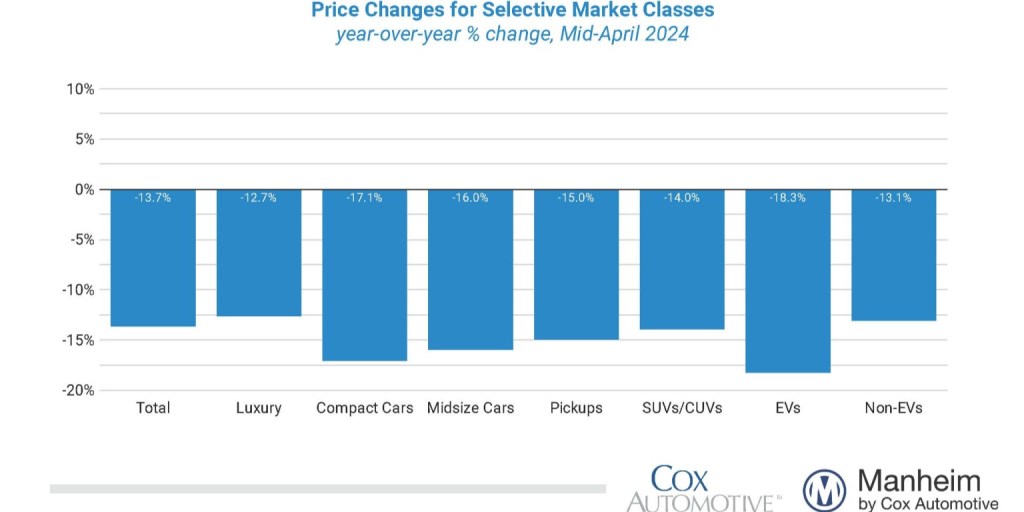The new standards are part of a broad push to get more Americans into electric vehicles, and reduce the environmental cost of driving.
Don’t worry, we’ll just get even larger trucks that nobody actually wants to bypass these standards.
The larger truck exist b/c of the standards. It’s more economical to change the weight class of a vehicle than it is to make the vehicle more environmentally friendly.
Edit: “more economical” -> “more environmentally friendly”
I’m 70% sure that the larger truck exists because exceptions have literally been made to the law on purpose due to lobbying, which is why every company pivoted to them.
As far as I am aware, current fuel economy standards are primarily determined by the size of the wheel base. Some years ago, the EPA went from a reasonably managed chart to a specific formula that gets a little extreme on the ends.
So you end up with craziness like a 95 ranger required to have 60mpg to meet the standard, and a 2024 f35 super mega ultra cab long bed to have like 3mpg to meet standards. (Numbers are made up, but that is the main idea as I understand it)
Yes. Basically someone made a formula years and years ago about what they believed new cars mpg would be based on very generous speculations. And it’s never been adjusted. The formula is based on the a bunch of variables but ends up boiling down to altering the footprint.
Large trucks exist because of wheel base allowance. Small, slow, borderline useless cars exist to keep fleet average low.
People buy trucks for towing and hauling, and bigger is better and safer for towing.
The real problem is every other type of vehicle has become so useless and disposable (shittily made) to meet fuel economy standards that you can’t tow anything with them and are forced to buy a raging-mega-huge truck to get a high enough GCWR/GVWR and big enough motor to safely and reliably haul stuff.
You may live somewhere where people constantly tow travel trailers or large boats, but this isn’t the case everywhere. Loads of people buy trucks with the idea the bed will be used every other weekend, then they end up commuting to an office job and getting groceries. If they were primarily used for hauling things around, the average truck wouldn’t have a larger passenger cabin than its cargo bed.
Station wagons can just as easily go to the hardware store and pick up full sheets of plywood, load up the lawn mower and trimmer, and as much sporting equipment as a family could wear. What wagons don’t have is the aggressive design that pick up trucks have come to be.
Most cars could tow a single axle utility trailer if you needed to move what I mentioned - even appliances or furniture. I know a couple that tow a two person caravan with a Mini Cooper. Even when someone does need larger weight or volume capacity on a regular basis, a van has most of the benefits of a pick up truck with better fuel efficiency.
Just to bolster your point, I rented a U-Haul trailer for all my stuff last time I moved, including an enormous 3 piece solid oak entertainment center, and pulled it with a vw Jetta wagon.
Couldn’t put it on the roof? I saw a wagon once with a chest freezer strapped to the roof and couldn’t stop laughing.
U-Haul is a titan of the moving industry, but it’s still surprising how few people would consider an occasional rental, be it a trailer like you used or even a truck, as part of owning a regular car. You spent around $100 to rent that trailer for a day? Imagine spending quadruple that - every month for a decade - just to ensure you have 24/7 access to 24 square feet of cargo space. Not to mention double in fuel compared to your Jetta.
Even ignoring the renting aspect, pretty well everyone knows a couple people that already have a pick up truck. Just borrow it for a day or two when you do a project or buy a new stove, fill the tank, and buy them their beverage of choice. It’s not complicated.
More people should be like you.
Last time I moved I rented a U-Haul. It was uneventful. Reserved it, picked it up, used it, returned it.
These people spend a years salary on oversized crap that gets terrible efficiency, kills pedestrians, blocks views, just on the off chance they can move something once a decade.
There was this lazy shit that worked at a place I was at once, fairly confident he has antisocial personality disorder. Guy makes a dollar over minimum wage per hour and bought a F250. Yes the person who works maybe 45 minutes a day is going out there moving lumber on the weekend
I agree. A truck can be a good option for some, but as you point out, most people aren’t doing a DIY project each weekend. The F150 can be optioned out to a six figure price tag. It’s inconceivable to me.
I’m acquainted with the owner of a middle sized plumbing company, and he had a close call with a dog that got loose one day. Not his fault, and he was able to stop in time, but nonetheless it bothered him. Couple months go by and he switched all his service trucks out for transit vans.
The newer style vans with the slanted front end gives far more visibility, twice the cargo space without having to climb up into the bed, they don’t weigh as much, and are more fuel efficient. All at the same price point.
An unfortunate side effect of modern life is that many people see purchases like a vehicle or a house as these monthly costs that, on the face of them, they can afford. The trouble is they don’t consider the overall cost of the purchase, let alone the ongoing cost in terms of routine maintenance and unexpected repairs.
It’s a shame, but when something is marketed as though it’ll make you the toughest in town, who wouldn’t pay $181.50 weekly at 0% APR ~for the first three months~.
I am just going to point out that my in-laws (who live in the developing world) run their rental properties, farm, and general store with two motorcycles and a tractor. That tractor btw I want to shot with a gun and put it out of its misery since I am pretty sure it’s diesal ass should have died in the 1980s. I am pretty confident that if two people in their mid-60s can do it the vast vast vast majority of people don’t need an oversized pickup.
Also I have been involved with construction since my uni days and just about every contractor I have dealt with has a van.
People buy trucks for towing and hauling, and bigger is better and safer for towing.
All the lifted duallies with caps and rubber band tires would say different.
I never ever see people towing and hauling with those machines. My Honda Civic is 16 years old and is fine, my car before that was a Nissan Sentra and died at 22 years old.
New cars are not shitty.
New cars are kinda shitty. They collect a ton of data, don’t let you actually drive, have a million unecessary features built in to try to reduce the stupidity of drivers who should be nowhere near a motor vehicle and are super ugly to boot.
I do know a lot of people who tow, but I’m in motor racing circles where people are regularly hauling race cars through multiple states every week.
New vehicles are like that.
If you think your new truck doesn’t do all the same data collection shit, you’re sorely mistaken. They’re all made to make a profit. If they can collect data and profit off of it after the sale, they’re going to. Trucks aren’t exempt from this.
Well yes, I don’t have a truck. I have a performance sportscar from the early 2010s instead. They’re all bad past early 2010s tbh.
I love that new vehicles ae more efficient, but everything else sucks. The car market needs to be shaken up. There’s no real competition anymore. A new company could probably make so much money by using modern technological advances, but including all the manual dials and things we used to get standard, and preferably without the data harvesting.
Yes, but they’d miss out on the long term revenue, which is what everyone is chasing nowadays. There’s be no investors.
Tbh as a car enthusiast there’s been a few advances I’ve been interested in, but nothing really game changing in the affordable range.
You don’t have to buy a car with all that garbage. You can just get a base model economy car.
Those are the base models for the most part. I’ve yet to see a new car better than something from 20 years ago
Supposedly they want us all in EVs, but American manufacturers aren’t producing shit except for Tesla which are safety hazards, and they effectively banned Chinese competition that could have actually accomplished it. US car manufacturers will likely ignore these new standards by pushing more “light trucks” that are exempt.
Light trucks aren’t exempt, but have a different standard. The article posted lacks a lot of detail. First off, 50 mpg is just the expected average given the mix of “light trucks” and cars. The actual standards are 65 mpg for cars and 45 mpg for “light trucks.”
The new standards require American automakers to increase fuel economy so that, across their product lines, their passenger cars would average 65 miles per gallon by 2031, up from 48.7 miles today. The average mileage for light trucks, including pickup trucks and sport utility vehicles, would have to reach 45 miles per gallon, up from 35.1 miles per gallon.
https://www.nytimes.com/2024/06/07/climate/biden-mileage-electric-vehicles.html
So actually the light truck standard isn’t far off of the 50 mpg figure this article inexplicably comes up with even though that’s not the standard for either cars or light trucks under the new rules.
Heavy trucks and vans also are included in the policy with a greater percent increase than for cars and light trucks (though beginning from a lower floor).
Aptera, baybeeee.
Also, ev prices are way down and their efficiency is going to keep going up.
https://electrek.co/2024/04/18/ev-prices-down-18-last-year-drastic-price-cuts/

Prices for cars in general was at an all time high. Don’t piss on my shoe and tell me it’s raining. They’re still way overpriced.
You said the prices were too high, here is proof that the prices are coming down, almost 20% in a year.
You said American manufacturers aren’t making cheaper EVs, this article talks about cheaper American EVs.
You cried that American EV manufacturers are going to try to trick their way around regulations, while apterra is making 400 to 1,000 mile range EVS with solar charging 40 mi a day, a very clear example of auto innovation.
Don’t throw a tantrum because your complaints were so flimsy.
You said the prices were too high, here is proof that the prices are coming down, almost 20% in a year.
20% down after increasing overall for the last decade is not proof. You sound like some marketing manager telling me how the price of cereal has dropped by 20% afte you rose the price for the last 5 years by 300%…
You said American manufacturers aren’t making cheaper EVs, this article talks about cheaper American EVs.
No where did I say that …
You cried that American EV manufacturers are going to try to trick their way around regulations, while apterra is making 400 to 1,000 mile range EVS with solar charging 40 mi a day, a very clear example of auto innovation.
Yeah didn’t say that either…and aptera is a tiny company that doesn’t even have a final release on the car from their website… it’s probably going to be vaporware just like most of these EVs that sport massive mileage claims.
Don’t throw a tantrum because your complaints were so flimsy.
Lol yeah I’m the one throwing the tantrum…you EV militants are hilarious.
It’s very clear you find hard evidence hilarious.
'Vaporware".
Don’t use words you don’t know the meaning of because you’re embarrassed of being proved wrong.
Lol ok kid, please show me this ev that’s in production and has been tested
That’s what the entire article i provided is about. Don’t blame other people because you never learned how to read.
Just an honest quick question. Do you hate on EV’s because fox “news” tells you to?
I don’t hate on EVs, I think they’re great. The applications they have are for city drivers not for rural and long haul people or even people who live in apartments. They’re getting there but right now isnt the time to try and push everyone to EVs forcefully.
Fair, I do think however, more people could use them but are falling for the propaganda. Apartment living could be an issue, especially if you can’t charge it at your workplace. Almost anyone with a house though, could get one and likely benefit from it.
GM has the Bolt, and now the Silverado, Ford has the MachE and the Lightning, Dodge is catching up, mostly with Jeep of all brands.
The Jeep wrangler PHEV is the top selling hybrid. The bolt and MachE are pretty great and can be found on the used market with decent miles for an affordable amount. The Lightning is a fantastic truck, better in almost every way that matters than the cyber truck. The Silverado EV is just launching but seems very capable.
Ford is the number 2 EV seller behind Tesla. If you think American manufacturer aren’t producing shit, you’re just not looking.
The only EV I can find from an American brand that is in any way appealing is the Bolt. Everything else is a giant truck or SUV, and to be honest I don’t feel safe driving such a huge piece of metal, and I don’t have the money to justify buying one. No American options are affordable or reasonably sized. The US is doing EVs in possibly the most unsustainable way possible.
The MachE is the same size as the bolt and it’s rather affordable on the used market. It doesn’t feel like an SUV to drive and barely looks like one. If you don’t like the look, then you don’t like the look, but that doesn’t mean that American manufacturers “aren’t producing shit” it’s that they aren’t producing anything that fits your aesthetic. They will, because they will have to if they want to keep selling cars in California. Just going to take time to get more styles out there.
The MachE is nearly a third larger than the bolt by weight, an already large car, as well as being larger than the bolt in every physical dimension, even if not by much (except for length, where there’s a nearly 2 foot difference). I just want a small compact car with enough range to get me to work and back and run a few errands. In 2000 most cars were reasonable sizes even in the US, but today you can find anything reasonably sized new. I don’t want an SUV or a “crossover”. In other coutures like China these vehicles are being built, but US politicians would rather protect the profits of car companies producing these massive, inefficient, unsustainable monster trucks for people to take to the office and back.
Look at the Hyundais, ~300 mile range, 15 min battery charge, and they have a sedan and a cuv wagon thing. They are also some of the cheapest leases you can get, and dealers are overflowing with them. It’s basically the EV wishlist, but for some reason I don’t see many on the road.
Could you be more specific? I couldn’t find a single EV under $30k the cheapest one I could find on their website was $37.5k on their website. That’s not affordable, and 10k above where the bolt starts.
They are expensive to buy outright, but that’s arguably a bad idea anyway due to the depreciation. They are leasing Ioniq 5 and 6 for less than $250/month and $200/month: https://www.hyundaiusa.com/us/en/offers
It’s cheaper than most of the gas cars in terms of cost to own over the period. If you want to buy. The Kona electric is $32,xxx
I’m not the kind of person that wants a new car always. I’d rather have a car that will last me 20 years. With that in mind, leasing is almost always much more expensive.
I’m not the kind of person who wants a new car always either. I have a 15 year old Acura with 200k on it. At $300/month, I no longer have gas or maintenance expenses, and I don’t have to pump gas any more. Figuring in the cost savings, I figure I’m driving a $50k car around for around $100 month. Idk what will happen in 2027 when I give this thing back to them, but it definitely would have cost me more than $3600 in repairs over three years with a 200k mile Acura.
For American manufacturers, Chevy has the Bolt (next year), the Blazer, and the Equinox. Ford has the Mustang Mach E. Lucid has the Air and the Gravity.
The Apterra will also be available soon and that thing gets like 600 mile range. It’s only a two seater though.
This isn’t aimed at just American manufacturers (Tesla, GM, Ford) but all vehicles sold in the US. People always seem to resort to “American protectionism” and other falsehoods when discussing stuff like this or the proposed ban on Chinese EVs, but either miss or purposely ignore the rest of the market in the US. Nearly every company that sells here has at least one EV and many others have excellent fleet MPG like Toyota with all their hybrid options.
This isn’t aimed at just American manufacturers (Tesla, GM, Ford) but all vehicles sold in the US.
Sure, but with almost no exceptions, the popular cars with the worst mileage are American ones.
Most other rich countries have much more ambitious plans that include phasing out fossil fuel only cars COMPLETELY, and are able to do so because their politicians don’t have to kowtow to the intertwined interests of their owner donors from Big Oil and Detroit.
People always seem to resort to “American protectionism” and other falsehoods when discussing stuff like this
Because it’s NOT a falsehood. See above.
American vendors aren’t producing more EVs because EVs don’t have mass appeal. See the currently tanking EV market and crashing prices on these vehicles. The market clearly cannot bear mass adoption of EVs at this time because the buyers for all those EVs we were making don’t exist.
Why? A mix of reasons. Poor infrastructure. Range anxiety in a car-centric nation. Total incompatibility with some lifestyles like apartment living at a place without a charger.
American vendors aren’t producing more EVs because EVs don’t have mass appeal
You’ve got that backwards: there’s less people buying American EVs than there should because there aren’t enough and cheap enough options from American companies.
Just about every other car maker on the planet has several popular EVs on offer, though, so they’re shooting themselves in the foot long term to avoid the expense of pivoting short term.
the market clearly cannot bear mass adoption of EVs at this time
Again, you’re wrong. I suspect you’re taking the bad build quality of Teslas specifically beginning to hurt their sales as a sign that all EVs are unviable. That’s not reality.
the buyers for all those EVs we were making don’t exist.
Again, other way around: people WANT EVs, but American companies are hardly making any good ones available. Almost all other car makers are, though, at increasingly competitive prices too.
And pickup trucks will be the size of a Mack truck.
Will be? I’ve seen literal Mack trucks smaller than some of today’s “regular” pickups…
I miss S10 sized trucks.
I’d love a truck like that little B-series Mazda had when I was in high school in the 80s. Or the little Toyotas. I just need something with a bed that gets decent mileage. Not something with 6 tires, needs a step ladder to get into, and enough room for 8 people. My penis is big enough already. 😂
Remember the 80’s diesels that got near 40mpg? No power but great economy.
I also had a B-series in high school that I posted about in another thread, with a cap on the back it was great for camping and hauling things around. So many good memories. A setup like that is also perfect for many contractors.
I went with the Maverick for a work truck and I’m very happy with the choice. 30mpg and I don’t have to climb up to get a ladder. Ford is an idiot for not making this a plug-in, I’d buy 2 more on the spot.
if it doesnt apply to suv’s then it is useless
it is slightly less strict on SUVs but it does apply to them. Smaller cars are going to require a 10% increase by 2031 but SUVs and pickups will only require 6%
The fuel savings translate into about $600 less in gas costs over the life of a new vehicle, NHTSA projects.
I don’t understand this. Let’s be extra safe and say I currently drive a car that gets 30 mpg 15k miles per year and the average fuel price was $3.60. If I switched to a vehicle that got 50 mpg, my savings per year alone would be $720.
15,000 mi / 30 mi/g x $3.60/gal = $1,800
15,000 mi / 50 mi/g x $3.60/gal = $1,080
$1,800/yr - $1,080/yr = $720/yr
Still being extra safe, let’s assume the car only makes it 100k miles, that’s a savings of ~$4,800 for the life of the vehicle.
100,000 mi / 15,000 mi/yr = 6.67 yr
6.67 yr x $720/yr = $4,802.40
$4,800 > $600
Again, this is being safe with a car that is fuel efficient, a person that travels a relatively short amount, and with low fuel prices. What am I misunderstanding??
Maybe that is compared to the current fuel efficiency standard? The current standard for cars is 46 mpg.
It also assumes gas prices don’t go up!
Stupid EPA laws sacrificed all the cool lightweight sports cars and utility trucks for giant hunks of useless metal which people use exclusively to drive on the highway.
Big 3 already deleted all their compact car production teams, they make all their bank from SUVs and mega sized trucks.
This will change basically nothing.
I’m a little confused, how is the EPA responsible for vehicle size increasing?
I’ve posted about this before so I’m just going to copy it here
No, vehicles have gotten larger because of the same problem as most of the issues in the United States: politics!
You see automobile manufacturers have to meet an average fuel economy across their entire fleet under the CAFE (Corporate average fuel economy) act of 1975. CAFE was a good idea as it forced the auto industry into actually improving on fuel economy year after year throughout their entire fleet or be met with steep fines for ever 0.1mpg off the target.
In 2011 CAFE was changed which directly caused the auto market we have today. See in 2011 the formula on how you’d calculate your fleet’s avarage MPG got changed to now factor in vehicle footprint as a variable which auto manufactures quickly caught on to mean the larger a vehicle is the smaller their entire fleet’s MPG has to be.
On top of that in 2012 “medium-duty trucks” was added as their own category with a lower MPG requirement meaning if your truck or SUV fell into that category then you would have a smaller MPG target for your entire fleet.
Now put yourself into the shoes of an early 2010s auto manufacture, would you rather design small and light vehicles that require you to meet a pretty high fuel economy level across your entire product range or would you inflate the size of your vehicles and move all R&D into finding ways to get your entire fleet classified as a medium-duty truck/SUV with a smaller MPG requirement? Of course you are going to take the latter.
The changes to CAFE in the 2010s killed small vehicles as we knew it. Ensured light duty trucks stayed dead domestically built or chicken tax be dammed. Caused the explosion of crossover SUVs to flood the market. All while making vehicles more dangerous and worse for the environment.
My understanding of the current situation is that EPA Guidelines give a lot of wiggle room / outright don’t control vehicles above a certain size. Therefore manufacturers are reducing the vehicles that actually get regulated by those guidelines in favor of monster trucks for grocery getters.
Ah, right, that’s correct there are regulations in place for “passenger cars.”
Regular cars are hit by the regulations, but trucks are exempt.
Essentially, the guidelines set a minimum MPG/ton, or something like that. Whether vehicle manufacturers increase MPG or increase weight, both have the same effect. Manufacturers figured out they could save money by not increasing fuel economy and also make more money by making larger vehicles and selling them as if they’re premium for being larger.
It’s not enough.
Yep, that’s a low bar.
My car, a 25 yr old Skoda Octavia TDi gets about that mileage.
Imperial gallons or US gallons?
L/100km. Standard fuel efficiency measurement in metric countries
My old Geo Metro could do that.
My mom said the same thing. She also said that 4 moderately strong people could move her geo metro if it was parked in the wrong spot.
I have been a part of a group of people that moved a geo metro across a parking lot. Took 6 high school kids about 5 minutes.
the Geo was both awesome and shitty. I wish 2 seat cars became more of a thing. I hardly ever use the back seat, and it’s not like anyone can afford to have kids anyway.
2 seat cars are a thing, but they’re typically low-clearance sports cars.
and the sprint (the earlier version of a metro) before that, even… in the 1980s.
Not sure why this is news. The current economy standard is 46 mpg.
Keeping on the right path is still a good thing. Also, it’s news because it’s new. That’s what that word means.
Why don’t politicians ever set these targets in their own terms?
This is six years away from when he’ll get back in, effectively punting the problem to the next president.
R&D, engineering, manufacturing process changes, supply chain changes (I think this pretty much requires hybrid) all the way from mining, etc takes time. The world can’t change on a dime.
So?
He could set a midpoint in his own term.
3 years is nothing for this kind of change. Things take way more time than you think.
Nothing for the first five years then all of it on the sixth?
When a new car model with a new engine comes out, is it all at once? Why don’t they put out the new engine in bits and pieces? Not how it works.
There’s plenty you can change to improve fuel economy without replacing the entire engine design.
-
Fuel maps (potentially at the expense of power)
-
Transmission shift maps (at the expense of acceleration)
-
Lighter materials elsewhere in the car (this one actually is better for performance too!)
-
Better stock tires
-
Final drive ratio (again, sacrificing acceleration) or gearing in the transmission if necessary.
Compromises will be have to be made for sure, but they can be spaced out so all the legwork doesn’t have to be done at once.
Of course I didn’t even mention hybridization because that’s not a minor change, but some manufacturers might still opt for it and you could keep the same engine technically.
Those are such small things. Not even sure you can do some because of the way mileage is calculated - pretty sure part of it is “accelerate from this speed to this speed in this time, so many times”.
-
The rules, issued by the National Highway Traffic Safety Administration, call for improvements over a five-year span starting with 2027 models
So they did exactly what you suggested. We also have current rules in place that are increasing fuel efficiency over time. It’s not just nothing and then meet this standard by 2031, it’s improving by 2% per year, every year, starting in 2027 (the beginning of the time period for the newest set of rules). The article posted is just very light on details. The article is just quoting where they would be at, in 2031, with those yearly goals. So current rules are that cars be at 55 mpg by 2027, and the new rules rate beginning that year, would be 56 in 2028 etc until at 61 mpg for cars in 2032 (and 45 mpg for light trucks)
https://www.nhtsa.gov/press-releases/new-fuel-economy-standards-model-years-2027-2031
10% yearly increases for heavy trucks and vans as well.
What targets exactly? Should every policy be limited to just their term? That completely removes the possibility of any target that takes a long time to reach. It would be a waste of time and resources to do smaller increments and then revisit them.
Almost every policy put into place will have effects that future presidents have to deal with. Do you actually care about this in principle or do you just not like this policy?
How do you stay accountable when you don’t set limits in your own term?
I don’t mind long-term goals, we need them, but there should be milestones and frankly I’m surprised it’s apparently an unpopular opinion.
How do you stay accountable when you don’t set limits in your own term?
You don’t. Even if they’re in office, there’s nothing you can do. What do you think they’d do to Biden? Jail him? Fine him? You vote in people who align with what you want put in place, then have the separate parts of government check each other.
I don’t mind long-term goals, we need them, but there should be milestones
I addressed that in my previous comment. Nobody’s wasting time and resources. Such a limitation would cripple every president and make them damn near useless. They’d spend most of their time in office recalculating milestones, which would be incredibly small, at best, and impossible at worst.
frankly I’m surprised it’s apparently an unpopular opinion.
Because it kinda indicates that you haven’t really thought about this or you’re just not aware of how things happen in life. You’re coming off as management that’s never worked on the floor and have no idea about what’s actually feasible. It’s a good way to have everybody despise you.
Using this as an example, let’s say it was done at the start of Biden’s 1st year, what percentage should he set per what time period, and do you really expect car manufacturers to recreate their vehicles each period?
Manufacturers need time to meet targets. And the final percentage would be incredibly small, because it would be only four years. Whenever you see a product hit the market, development has starts years prior.
Biden for sure won’t get back in he’ll be like 260 years old at that point
I was referring to 2025.
That’s why I said six years before 2031.
Oh I see woopsies
.
He’ll still be 256 years old then
I like the idea in principle, but hasn’t the market already said that it cannot produce more efficient ICE vehicles? We can legislate better cars, but can we actually build such cars and sell these? This sounds off (hybrids exist), but bear with me and let me explain.
As another commentator wrote, it’s much more cost effective to simply sell larger cars to go around the rules. Why is it better to sell much larger, much more expensive cars? Maybe it’s because there is not a good, cost effective solution in this problem space. Many consumers don’t want to buy electric cars due to lack of infrastructure, and it’s a complete non-starter if you can’t charge at home such as if living in an apartment. Right now, the EV market is seeing trouble moving inventory. Automakers prefer not to produce or sell smaller cars because it doesn’t make sense for some reason, and part of that reason could be an impracticality of a small, low cost, mass market, yet efficient car that people will actually buy. Maybe a small hybrid that meets this goal is still too expensive for enough of the consumers who want to buy a compact car. The trend to larger cars might be telling us something.
Overall, I think I favor the legislation, but I’m concerned that we’re not thinking this through enough. We can legislate the requirement. Are we also taking steps to expand charging access and have a plan to make such cars with consumer appeal outside of the premium segment?
Automakers prefer not to produce or sell smaller cars because it doesn’t make sense for some reason
it’s mainly two things:
automakers and their dealers make significantly more profits off of big cars and trucks,
and then also the typical buyer mindset that ‘bigger is better’.
The reason is years and years ago the EPA formula set some goals based on speculation that future technology would keep up pace. And we can’t achieve those goals. But car manufacturers can increase the footprint of their vehicles to move the goal post.
Iirc, the original target was supposed to be something like 58 mpg; he’s lowered it. We’re fucking doomed, all of us, because a bunch of rich boomers don’t like change.
Does that stipulation include hybrids or just ice? Seems like it would be more easily attained in hybrids
I think many Hyundai and Kia Hybrids already exceed that so there’s not much point in including them but whenever exceptions don’t exist you can assume it affects everything.
Most new cars can do that already though can’t they? I’m not part of the ‘new car demographic’ but even when buying used cars, i wouldn’t buy one that had lower mileage that that.
I was looking at a Ford Focus station car from 2011 that did 21km/l and the target above translates to that too!
I like electric vehicles, but when will the charging infrastructure get better? People without garages, ones that live in apartments and cities don’t have a convenient way to charge an electric vehicle. Most people living without a convenient way to charge their vehicle can’t afford an electric vehicle either. Hybrids are a lot easier to have now until the infrastructure gets better and they meet the 50mpg.
I just went on a (2) 650 mile trip in my EV. It was fine. Took about 40 minutes longer than a gas vehicle. My car is an 800V vehicle with a great charging curve. Peaks at 240 KW and keep that high power for a lot of the curve.
You have to plan the trip out more because you don’t have a charger on every corner. Plugshare and ABRP help a lot. I had one issue with one charger. All others were plug and play. I wish we could move away from needing an app to charge.
Plugshare is great to plan things out for a long trip.
I see more and more stores and parking lots with EV parking/charging. Once it becomes a value-add for the average car user many apartments and shared parking spaces will start to include EV charging.
I don’t understand the comment arguing about upgrading power infrastructure. EVs don’t use more electricity to charge than say a fully electric water heater or any major appliances/tools that a maker has at their homes. Maybe in some more rural areas, but then again, those are the places that 3-phase 240v already exists to support farming/processing tools.
So I have an EV and solar. This gives me a very clear picture of my power usage. The EV adds a lot to my base power usage. And this is with a class 1 charger. A commercial class 2 charger is 4 times the power usage.
Orange is my power usage. Here is a day whew I came home at noon charged and then went out in the evening charging when I returned home. You can see how much it adds to the base draw. The spikes are my ac.

You can set it to trickle charge too though right?
Not really. Level 1 chargers are basically trickle chargers that run off a 120v outlet. Level 2 are 4 times the power running off 240v. Then you have the big fast chargers like the tesla super charger or chadmo.
You can change the amperage. That is actually one thing that makes people think they need a level 2 charger. Many charging cables that the dealership gives you default to 6A instead of 12A so people get like 16 miles charge overnight instead of over 30.
On a level 2 charger.
No. That is for level 1 chargers. Hyundai’s for instance default to 6A. People would be extremely pissed if their level 2 charger was defaulted to 6A since level 2 starts at 15A minimum.
Some poking around tells me that those are the maximums and good chargers can slow down. Furthermore cars can also just not take as much, like a low power appliance. So no you’re not forced to run it at full power and most days you’ll likely trickle charge overnight when electricity is the cheapest.
They slow shown when the vehicle gets close to max charge about 95%. But i’ve yet to see one where it has a setting you can change.
You probably already know this but a level 2 charger is actually more efficient than a level 1 charger. It’s counter intuitive, but the reason is that the car being powered on to accept a charge runs at around 400w, so immediately 1/5 of your draw on the level 1 charger goes to just keeping the car on. It’s better to charge faster and let the car sleep longer if you can.
Yeah i’ve considered putting in a level 2 charger but my level 1 does the job so i haven’t bothered.
If you add thousands of electrical car chargers to the grid without upgrading the carrying capacity of the transmission lines and the power generating capacity of the power plants you’ll have more demand than what the utilities can supply.
It isn’t even the charging infrastucture, it’s the distribution infra. There are a lot of upgrades from the main HV transmission lines to the last mile that need to be taken up by an order of magnitude if everyone starts to drive EVs.
I mean, it’s not impossible, but we’d better start now. Hell, AC use alone has brought places like Texas to its knees, now add EVs to that demand.
Texas has those problems because they refuse to be a part of the national grid. EV charging/demand has little effect on a national sized grid. A fully electric water heater draws more power for long periods of time than any EV I am aware of. And those are everywhere in the US.
3-phase 240v service is already available in most modern homes and def available to most apartment complexes that have to supply power for hundreds of apartments.
240v is available in most homes but three phase is very rare for residential areas unless they are right next to an industrial zone.
Also a standard 4K heater runs about 3 hours a day and is usually the biggest power draw in a house depending on ac. That is about twice the draw of a class 1 home charger but the charger is probably being used for at least 6 hours for a daily driver. So it’s realistic to almost double a houses daily use with an EV.
EVs are great but we do need to upgrade the infrastructure to handle them. It’s still a lot less infrastructure then we use to distribute gasoline.
Not against EVs, because I would love to have a Hyundai N. and can’t wait for the EV revolution.
Now lets say the water heater defense is logical. Lets say we double the water heater load on the grid then.
Over the span of a few decades? Considering our capacity and throughout is increasing, I think that would be just fine.
There is no residential 3-phase anywhere that I’ve ever seen in North America. Maybe some place in Europe has it but not to my knowledge. I have seen people put it into something like an acreage or farm at great expense, but the idea that a house will have 3-phase by default is silly.
Maybe an apartment complex would have a 480 or 600V 3-phase high-leg supply, and I guess they could run that to the parking areas.
My uncle had 3-phase to his house for a heavy duty workshop, so it is possible, but I believe he had to pay a lot up front for it, significantly more than a single phase 240V hookup to a new house would have been.
Correct, like anything else if you have money you can have something custom done.
But no standard built house in the US has 3 phase power.
But it’s really not. Sure, we need serious upgrades to support the end result, but that’s not a place we suddenly get to. The same years/decades it takes to get there are what we have to grow infrastructure to match.
Distribution infrastructure handles current power needs and has some buffer built in to handle expected growth, so no big deal to install more chargers. Distribution infrastructure already reacts to growth - as it approaches capacity, utilities have incentive to build more. In that sense, this is just like all other power uses, and no big deal.
The real difference is the speed. Most people are expecting a faster transition to EVs and electrification than distribution growth has historically supported. While this does need to be addressed, there’s no reason for it to block buildout of chargers. It’s fine in the short term and in the long term, the biggest driver of increased transmission will be that demand.
The move to EVs will not happen overnight. Expect it to take a few decades.
Texas’ (and California’s) issues are due to massive deregulation. Having extra capacity than is necessary esta into profits. So companies try to only have as much infrastructure as absolutely necessary. Additional AC use from “100 year” heatwaves (that are now happening every few years) were not really something they planned for and since they do not have the extra capacity, there are issues. They basically just have to properly model it…or have a more regulated market that makes sure there is additional capacity.
Landlords have even better govt incentives to install chargers than homeowners do. But why should they? It’s all down to motivation. Chargers still cost money and do not make a profit in themselves.
So how do we change that? The best way is for EVs to become ever more common. Landlords will install chargers when there’s enough demand, when it’s a competitive factor that makes a difference in whether they get tenants and how much they can charge. Currently there are only a few EVs out there so it doesn’t matter: landlords can just ignore them.
I wonder more about HOAs. I know they’re notoriously conservative/reactionary, but they are run by homeowners. They are closer to the people who want chargers. Why aren’t more of them installing chargers?
People without garages are fine if they are in a house. You just need an outlet within reach of your parking spot. Apartment dwellers do need a solution. Orange Charger sells level 1 and 2 chargers targeted toward apartment complexes. The systems cost $600 (level 1) or $750 (level 2) and they deal with the payments. The power company in my city has level 2 chargers throughout the city that are near apartment complexes.
As far as affordability, a used 3 year old Bolt can be bought for $16k. My state has added on another discount which brings the cost down another few thousand. Considering you will save about $1000 per year in gas costs, that’s a pretty good deal.

















